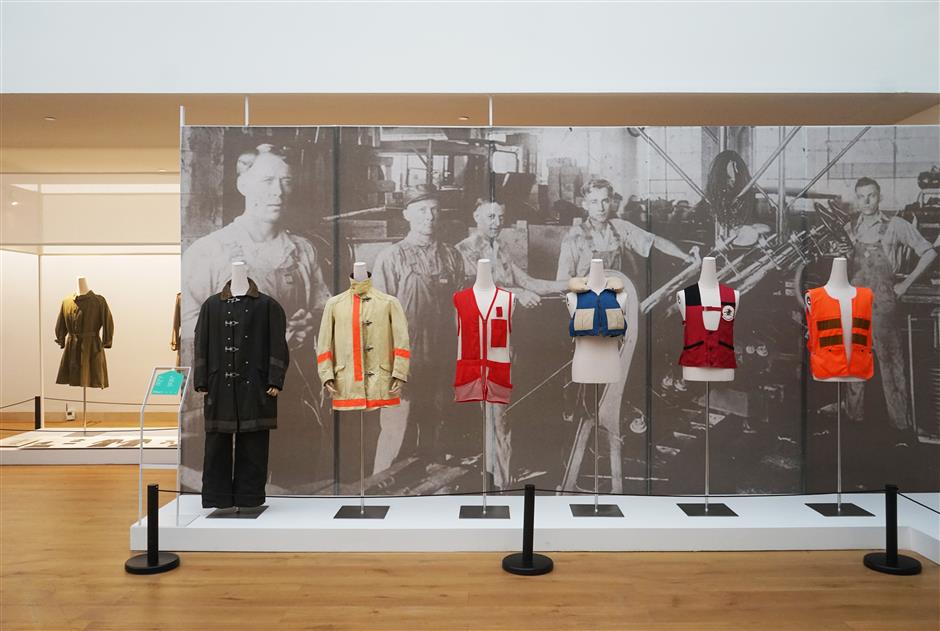Fashion passion: Exhibition details changes in Western menswear
China's first exhibition with focus on the changes in Western menswear is under way at China Design Museum through March 12.
Visitors can learn about social changes, lifestyles, values and aesthetics of different ages through the exhibits.
"For a long time, when I saw many male celebrities wearing unfit suits on various occasions, I had a strong desire to hold an exhibition that explores the development and social changes of Western menswear in a bid to design better clothes," said Hang Jian, curator of the Hangzhou museum.
With some exhibits on loan from China National Silk Museum, the "Men's Fashion Life in the 20th Century" exhibition is divided into five sections, namely Gentleman in Suit, Specialized Garments, Urban Sports and Casual Wear, Spirit of Rock 'n' Roll, and Pop and Consumption.
Clothes are the culture that people wear.
Visitors can see how the high-class elite haute couture developed into mass ready-to-wear fashion within a century.
The exhibition begins with suits, considered the core in the development of menswear. A myriad of significant styles of suits in the 20th century reflect the trend transferring from strictness to simplicity and practicality.
The wars and changing social classes also had an impact on menswear. More and more people preferred convenient and practical clothes rather than delicate items.

The "Men's Fashion Life in the 20th Century" exhibition is on at China Design Museum through March 12.
Men's fashion was generally based on a conservative template: a shirt and tie, a plain, handmade suit, a hand-knitted jumper.
"Expensive formal suits reinforced the hierarchy and the superiority of certain classes, and also showed the obedience of social aesthetics, etiquette and lifestyles at the time. They were the identity tags of men's status, wealth and gentility," said Ji Xiaofen, curator of China National Silk Museum.
The crucial turning point of menswear occurred in the second half of the 20th century.
In the late 1950s, the modernists initiated a new youth culture. Italian slimline suits, bumfreezer, cheap and colorful suits became popular, which evolved into a new trend of menswear.
The slim-fitting trousers and collarless jacket, which were famous for being worn by the Beatles, were the most popular items for trendsetters. That was the so-called "Peacock Revolution" that took place during the 1960s.
Hipsters challenged the staid rules of masculine etiquette that had persisted since Victorian times and started to wear velvet and other elements previously judged to be too feminine for a man.
"The 'Peacock Revolution' ensured that gorgeous dresses were no longer a privilege for women. Men were trying to achieve gender equality in daily dressing," said Ji.
As the 1970s approached, the traditional distinctions between menswear and womenswear became blurred. Blue denim jeans, at first a counter-cultural garment, were widely worn and promoted by global brands. Clothing became increasingly unisex and informal.
"The exhibition presents the diversified aesthetics of menswear after the 1970s, including Rock 'n' Roll and Pop art. There was no longer a clear distinction between the dressing of the elites and the masses. Everyone is the master of their own fashion, and clothes become the best expression of own personality," Ji pointed out.
China Design Museum opened in 2018 inside the Xiangshan campus of the China Academy of Art in Hangzhou. The museum was built and founded at a time when China started to realize the significance of design, and more Chinese manufacturers were seeking an upgrade from "Made in China" to "Created in China."

The suit and leisure wear popular in Cambridge in the UK in the 1920s
Exhibition info:
Date: Through March 12 (closed on Mondays)
Venue: China Design Museum
Address: 352 Xiangshan Rd
象山路352号
















